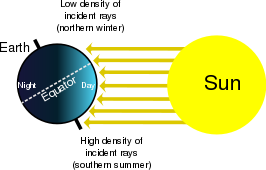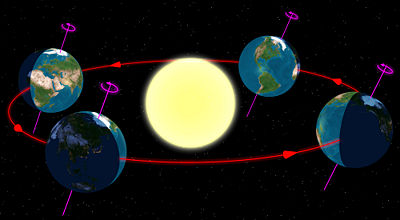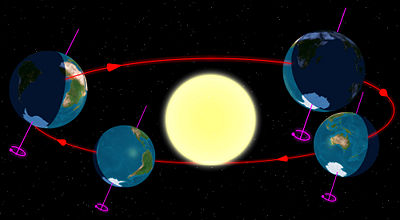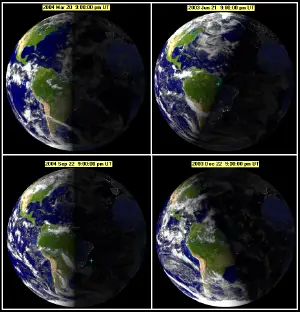Season
| Part of the Nature series on Weather |
| Seasons |
|---|
|
Dry season |
| Storms |
|
Thunderstorm · Tornado |
| Precipitation |
|
Fog · Drizzle · Rain |
| Topics |
|
Meteorology |
A season is one of the major divisions of the year, generally based on yearly periodic changes in weather. In temperate and polar regions, four seasons are generally recognized: spring, summer, autumn or (fall), and winter.
In some tropical and subtropical regions, where the amount of precipitation varies more dramatically than the average temperature, it is more common to refer to a rainy (or wet, or monsoon) season and a dry season. In other tropical areas, three types of seasons are recognized: hot, rainy, and cool.
In some parts of the world, special "seasons" are loosely defined, based on significant phenomena, such as a hurricane season, tornado season, or a wildfire season.
|
| ||||||||||||
Causes and effects

This is a diagram of the seasons. Note that, regardless of the time of day (that is, the Earth's rotation on its axis), the North Pole will be dark, and the South Pole will be illuminated; see also arctic winter. In addition to the density of incident light, the dissipation of light in the atmosphere is greater when it falls at a shallow angle.
The seasons result from the Earth's axis being tilted to its orbital plane; it deviates by an angle of approximately 23.44 degrees. Thus, at any given time during summer or winter, one part of the planet is more directly exposed to the rays of the Sun (see Fig. 1). This exposure alternates as the Earth revolves in its orbit. At any given time, regardless of season, the northern and southern hemispheres experience opposite seasons (see Fig. 2 and Month ranges of seasons, below).
Seasonal weather fluctuations also depend on factors such as proximity to oceans or other large bodies of water, currents in those oceans, El Niño/ENSO and other oceanic cycles, and prevailing winds.
In the temperate and polar regions, seasons are marked by changes in the amount of sunlight, which in turn often causes cycles of dormancy in plants and hibernation in animals. These effects vary with latitude, and with proximity to bodies of water. For example, the South Pole is in the middle of the continent of Antarctica, and therefore a considerable distance from the moderating influence of the southern oceans. The North Pole is in the Arctic Ocean, and thus its temperature extremes are buffered by the presence of all that water. The result is that the South Pole is consistently colder during the southern winter than the North Pole during the northern winter.
The cycle of seasons in the polar and temperate zones of one hemisphere is opposite to that in the other. When it is summer in the Northern hemisphere, it is winter in the Southern hemisphere, and vice versa, and when it is spring in the Northern hemisphere it is autumn in the Southern hemisphere, and vice versa.
In the tropics, there is no noticeable change in the amount of sunlight. However, many regions (famously the northern Indian Ocean) are subject to monsoon rain and wind cycles. Curiously, a study of temperature records over the past 300 years (David Thompson, Science, April 1995) shows that the climatic seasons, and thus the seasonal year, are governed by the anomalistic year rather than the tropical year.
In meteorological terms, the winter solstice and summer solstice (or the date maximum/minimum insolation) do not fall in the middle of winter and summer respectively. The heights of these seasons occur up to a month later due to seasonal lag. Seasons though, are not always defined in meteorological terms (see Reckoning below).
Compared to axial tilt, other factors contribute little to seasonal temperature changes. It's a common misconception that the seasons are the result of the variation in Earth’s distance to the Sun due to its elliptical orbit. (Pidwirny PhysicalGeography.net [1]) Orbital eccentricity can influence temperatures, but on Earth, this effect is small and is more than counteracted by other factors; research shows that the Earth as a whole is actually a few degrees warmer when farther from the sun. (Phillips The Distant Sun (Strange but True: the Sun is far away on the 4th of July)) (NASA Science@NASA ) Mars however experiences wide temperature variations and violent dust storms every year at perihelion. (Ho, et al. Radio Wave Propagation Handbook for Communication on and Around Mars)
Polar day and night
A common misconception is that, within the Arctic and Antarctic Circles, the sun rises once in the spring and sets once in the fall; thus, the day and night are erroneously thought to last uninterrupted for 183 calendar days each. This is true only in the immediate region of the poles themselves.
What does happen is that any point north of the Arctic Circle or south of the Antarctic Circle will have one period in the summer when the sun does not set, and one period in the winter when the sun does not rise. At progressively higher latitudes, the periods of "midnight sun" (or "midday dark" for the other side of the globe) are progressively longer. For example, at the military and weather station called Alert on the northern tip of Ellesmere Island, Canada (about 450 nautical miles or 830 km from the North Pole), the sun begins to peek above the horizon in mid-February and each day it climbs a bit higher, and stays up a bit longer; by 21 March, the Sun is up for 12 hours. However, mid-February is not first light. The sky (as seen from Alert) has been showing twilight, or at least a pre-dawn glow on the horizon, for increasing hours each day, for more than a month before that first sliver of sun appears.
In the weeks surrounding June 21, the sun is at its highest, and it appears to circle the sky without ever going below the horizon. Eventually, it does go below the horizon, for progressively longer and longer periods each day until, around the middle of October, it disappears for the last time. For a few more weeks, "day" is marked by decreasing periods of twilight. Eventually, for the weeks surrounding December 21, nothing breaks the darkness. In later winter, the first faint wash of light briefly touches the horizon (for just minutes per day), and then increases in duration and pre-dawn brightness each day until sunrise in February.
Reckoning
Four seasons
The date at which each of the four temperate season begins varies from culture to culture. In general there are three reckonings, "Astronomical," "Meteorological," and "Traditional".( Adams. The Straight Dope: Is it true summer in Ireland starts May 1?)
Astronomical
| Tradition | Meteorology | Astronomy | Months (North/South) |
|---|---|---|---|
| Winter | Winter | Winter | Jan/Jul |
| Spring | Feb/Aug | ||
| Spring | Mar/Sep | ||
| Spring | Apr/Oct | ||
| Summer | May/Nov | ||
| Summer | Jun/Dec | ||
| Summer | Jul/Jan | ||
| Autumn | Aug/Feb | ||
| Autumn | Sep/Mar | ||
| Autumn | Oct/Apr | ||
| Winter | Nov/May | ||
| Winter | Dec/Jun |
In astronomical reckoning, the seasons begin at the solstices and equinoxes. The cross-quarter days are the midpoints of the Astronomical seasons. The length of these seasons is not uniform because of the elliptical orbit of the earth and its different speeds along that orbit (see Kepler's laws of planetary motion).
In the conventional US calendar:
- Winter (89 days) begins on 21-22 Dec, the winter solstice
- Spring (92 days) on 20-21 Mar, the spring equinox
- Summer (93 days) on 20-21 June, the summer solstice
- Autumn (90 days) on 21-22 Sept, the autumn equinox
The cross-quarter days are considered seasonal midpoints:
- Winter: 5-10 Nov (Samhain, 立冬)
- Spring: 2-7 Feb (Imbolc, 立春)
- Summer: 4-10 May (Beltane, 立夏)
- Autumn: 3-10 Aug (Lughnasadh, 立秋)
Meteorological
| UT date and time of equinoxes and solstices on Earth | ||||||||
|---|---|---|---|---|---|---|---|---|
| event | equinox | solstice | equinox | solstice | ||||
| month | March | June | September | December | ||||
| year | ||||||||
| day | time | day | time | day | time | day | time | |
| 2018 | 20 | 16:15 | 21 | 10:07 | 23 | 01:54 | 21 | 22:23 |
| 2019 | 20 | 21:58 | 21 | 15:54 | 23 | 07:50 | 22 | 04:19 |
| 2020 | 20 | 03:50 | 20 | 21:44 | 22 | 13:31 | 21 | 10:02 |
| 2021 | 20 | 09:37 | 21 | 03:32 | 22 | 19:21 | 21 | 15:59 |
| 2022 | 20 | 15:33 | 21 | 09:14 | 23 | 01:04 | 21 | 21:48 |
| 2023 | 20 | 21:25 | 21 | 14:58 | 23 | 06:50 | 22 | 03:28 |
| 2024 | 20 | 03:07 | 20 | 20:51 | 22 | 12:44 | 21 | 09:20 |
| 2025 | 20 | 09:02 | 21 | 02:42 | 22 | 18:20 | 21 | 15:03 |
| 2026 | 20 | 14:46 | 21 | 08:25 | 23 | 00:06 | 21 | 20:50 |
| 2027 | 20 | 20:25 | 21 | 14:11 | 23 | 06:02 | 22 | 02:43 |
| 2028 | 20 | 02:17 | 20 | 20:02 | 22 | 11:45 | 21 | 08:20 |
Meteorological seasons are reckoned by temperature, with summer being the hottest quarter of the year, and winter the coldest quarter of the year.
Using this reckoning, the Ancient Roman calendar began the year and the spring season on the first of March, with each season occupying three months. This reckoning is also used in Denmark, the former USSR, and Australia. In modern United Kingdom and Ireland there are no hard and fast rules about seasons, and informally many people use this reckoning.
So, in meteorology for the Northern Hemisphere:
- spring begins on March 1,
- summer on June 1,
- autumn on September 1, and
- winter on December 1.
Conversely, for the Southern Hemisphere:
- summer begins on December 1,
- autumn on March 1,
- winter on June 1, and
- spring on September 1.
Traditional
Traditional seasons are reckoned by insolation, with summer being the quarter of the year with the greatest insolation, and winter the quarter with the least. These seasons begin about four weeks earlier than the Meteorological seasons, and 7 weeks earlier than the Astronomical seasons.
In Traditional reckoning, the seasons begin at the cross-quarter days. The solstices and equinoxes are the midpoints of these seasons. For example, the days of greatest and least insolation are considered the "midwinter" and "midsummer" respectively.
This reckoning is used by various traditional cultures in the Northern Hemisphere, including East Asian and Irish cultures.
So, according to Traditional reckoning,
- Winter begins on 5-10 Nov, Samhain, 立冬 (lìdōng),
- Spring on 2-7 Feb, Imbolc, 立春 (lìchūn),
- Summer on 4-10 May, Beltane, 立夏 (lìxià), and
- Autumn on 3-10 Aug, Lughnasadh, 立秋 (lìqiū).
And, the middle of each season is considered,
- Mid-winter: 20-23 Dec, winter solstice, 冬至 (dōngzhì)
- Mid-spring: 19-22 Mar, spring equinox, 春分 (chūnfēn)
- Mid-summer: 19-23 June, summer solstice, 夏至 (xiàzhì)
- Mid-autumn: 21-24 Sept, autumn equinox, 秋分 (qiūfēn)
Australian Aboriginal
| Month | Minang | Arrernte | Gadgerong | Tasmania |
|---|---|---|---|---|
| January | Beruc | Uterne | Mayurr | Wegtellanyta |
| Feb/Mar | Meertilluc | |||
| April | Pourner | Alhwerrrpeurle | Nguag/Gagulong | |
| May | Tunna | |||
| Jun/Jul | Mawkur | Alhwerrpa | ||
| August | Meerningal | |||
| September | Ulpulpe | Pawenya peena | ||
| Oct/Nov | Uterne urle | Bandenyirrin | ||
| December | Beruc | Uterne | Wegtellanyta |
In Australia, the aboriginal people defined the seasons by what was happening to the plants, animals and weather around them. This led to each separate tribal group having different seasons, some with up to 8 seasons a year. However, most modern Aboriginal Australians follow the Meteorological Seasons.
Seasons in images
In hemiboreal and temperate climates:
See also
ReferencesISBN links support NWE through referral fees
- Adams, Cecil The Straight Dope: Is it true summer in Ireland starts May 1? downloaded 24 June 2006
- Ho, Christian, Nasser Golshan, and Arvydas Kliore, Radio Wave Propagation Handbook for Communication on and Around Mars JPL Publication 02-5: 59-60, downloaded 23 June 2006
- Phillips, Tony, "The Distant Sun (Strange but True: the Sun is far away on the 4th of July)," Science@NASA, downloaded 24 June 2006
- Pidwirny, Michael PhysicalGeography.net, Fundamentals of physical geography, Ch. 6: Energy and Matter:(h) Earth-Sun Geometry, [2].downloaded 23 June 2006
External links
All links retrieved January 25, 2023.
- When do the Seasons Begin? (from the Bad Astronomer)
- Why the Earth has seasons article on h2g2.
- Indigenous seasonal descriptions (Australian Bureau of Meteorology)
- The Lost Seasons
- The Lengths of the Seasons (numerical integration analysis)
Credits
New World Encyclopedia writers and editors rewrote and completed the Wikipedia article in accordance with New World Encyclopedia standards. This article abides by terms of the Creative Commons CC-by-sa 3.0 License (CC-by-sa), which may be used and disseminated with proper attribution. Credit is due under the terms of this license that can reference both the New World Encyclopedia contributors and the selfless volunteer contributors of the Wikimedia Foundation. To cite this article click here for a list of acceptable citing formats.The history of earlier contributions by wikipedians is accessible to researchers here:
The history of this article since it was imported to New World Encyclopedia:
Note: Some restrictions may apply to use of individual images which are separately licensed.







